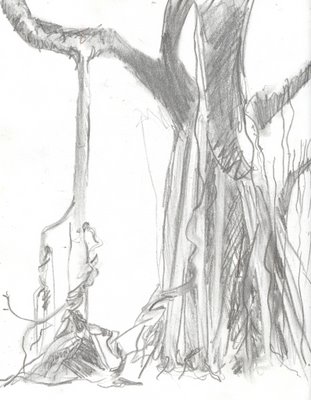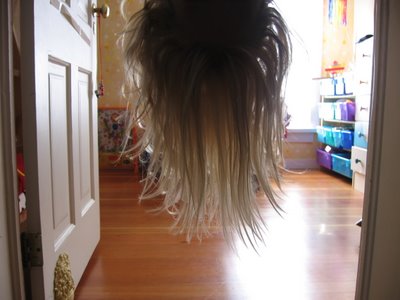 Craftsmanship is not a word I had ever entertained in the same sentence with the name Julian Schnabel. And because of my biases towards actually caring about the visual component of Visual Art, I had all but written him off in my mind. No, to be totally honest I had completely written him off.
Craftsmanship is not a word I had ever entertained in the same sentence with the name Julian Schnabel. And because of my biases towards actually caring about the visual component of Visual Art, I had all but written him off in my mind. No, to be totally honest I had completely written him off.Burning Inside.
Which is how I felt. I quickly cycled through the five stages of grief:
Denial:This couldn't be Julian Schnabel. There's no way.
Anger: Why would he do this? This isn't his territory! He should stick to his cracked china, dissonant colors, and crudely drawn figures!
Bargaining: OK, you can have stained glass, but you can't monopolize contemporary iconography or beauty.
Depression: Who am I kidding? I don't understand the art world. Maybe I should just quit.
Acceptance: You know, if he's starting to think about aesthetics that means there's a growing market for it. This could be a good thing for me.
You see, I felt as if the team for passion and sincerity in art had finally won a big name over from the dark side, or a Franciscan monk who had just converted a Benedictine theologian. Gothic references aside (and also my self-righteousness), I think that the slight aroma of humor and sarcasm did slip in at times to the detriment of this near mannered mastery of the more sincere pieces.
The artist has gathered bits of the Byzantine clerestory, alchemically bound the light into a Gothic exploration of contemporary subjects - the abject ascetic business man seated on an English bench; a forlorn Ophelia poisoned in her room of startling geometric beauty. But my favorite piece (above) hangs in the entrance, encouraging inquiry: the androgynous and slightly decaying princess of somewhere bearing witness to the Guernica death of innocence, caught between the diametric opposition of two cosmic forces. This is My One Desire.
Just as I grew warm with the thought, I glanced again at the name on the wall and my tepid soul reversed the sensation. It seems that I had not looked closely enough. All the hopes of the past half hour had been dashed upon the tiles of Clair Oliver's floor like the heart of a sordid lover. Well, perhaps not that badly, but I was sadly mistaken. The name on the wall was in fact Judith Schaechter and not Julian Schnabel. Well, of course, that explains everything.
But, this message is to Julian Schnabel if by some strange twist of fate he might come across this article: Oddly, I still harbor a dim and newly founded hope that you'll come join us while there's still time. The grass is truly greener over here.
And to Judith Schaechter, thank you for the beautiful work. It stands on its own regardless of what name is attached to it - a testament to time and man's quest for meaning. I am sincerely glad it was you and not him.
























